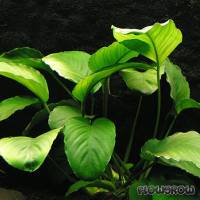



Anubias barteri var. barteri, named after the plant collector Charles Barter, is a very common, popular aquarium plant, mostly due to its uncomplicatedness.
In its natural habitat this plant grows on and in more or less shady, rapid-flowing rivers and rivulets in south-eastern West Africa. Here it often grows on large rocks or fallen tree trunks, firmly attached, above the waterline or semi-emersed, more seldomly fully submersed.
In the trade, this species is very commonly found. Smaller specimens of Anubias barteri var. barteri can be discerned from A. barteri var. nana quite easliy as their leaves have longer stalks.
Anubias barteri var. barteri is highly tolerant against bad growth conditions, it can live under very low lighting (0.25 W/L) and withough the addition of CO2. However, under lots of light and with CO2 added to the tank it grows faster and forms larger leaves. Water hardness and pH do not play an important role. A strong current is of advantage and helps preventing spot algae, especially under strong light. In order to reduce spot algae even further, high levels of phosphate are recommendable (2 mg/l), which also help with flower formation.
In contrast to the highly popular Anubias barteri var. nana, the rhizome of this variety tends to grow upright instead of along the substrate.
Its growth rate may be described as "slow" at best, however, A. barteri var. barteri belongs to the fastest-growing Anubias species.
For propagation, a piece of the rhizome is cut off. Parts that form lateral shoots are best suited for this purpose.
Anubias barteri var. barteri is nicely suited for the middle- and background of very large aquaria. It is a nice contrast to plants with a soft texture like mosses and fine-leaves stem plants.
Its leathery leaf surface makes it an ideal candidate for accentuating cichlid tanks with green hues. A. barteri var. barteri may be used as an epiphyte on hardscape or planted in the ground. In the latter case, please make absolutely sure that the rhizome is above the gravel to prevent it from rotting. This should be kept in mind for all Anubias species.
This Anubias variety is also very well suited for the use in a paludarium as it may grow partially emersed.
<a href="https://www.flowgrow.de/db/aquaticplants/anubias-barteri-var-barteri" target="_blank"><img alt="Anubias barteri var. barteri" title="Anubias barteri var. barteri" src="https://www.flowgrow.de/db/widget/aquaticplants/anubias-barteri-var-barteri" /></a>
[url=https://www.flowgrow.de/db/aquaticplants/anubias-barteri-var-barteri][img]https://www.flowgrow.de/db/widget/aquaticplants/anubias-barteri-var-barteri[/img][/url]
[widget=aquaticplants/anubias-barteri-var-barteri]Anubias barteri var. barteri[/widget]